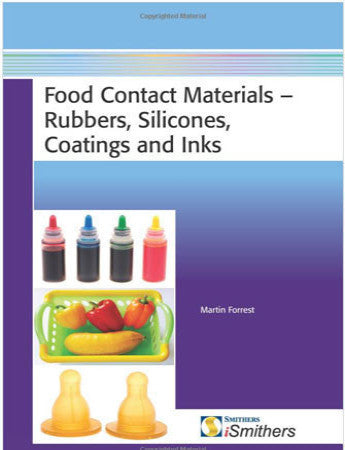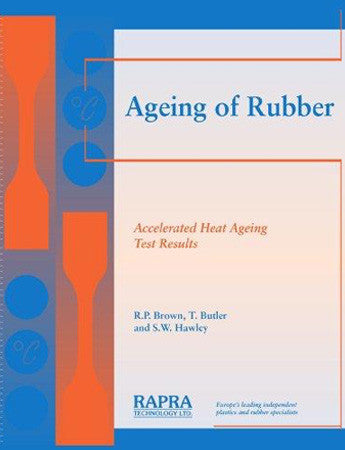Food Contact Materials - Rubbers, Silicones, Coatings and Inks
Food Contact Materials - Rubbers, Silicones, Coatings, and Inks, is an amalgamation of data from four recent projects. This report provides a wealth of information taken from the results and findings of research projects on: Migration Data of Food Contact Rubbers (Two projects), Rubber Breakdown Products, Chemical Migration from Silicones used in Connection with Food Contact Materials and Articles and An Assessment of the Potential of Migration of Substances from Inks and their Respective Coatings.
Each review provides an expert overview of the products as food contact materials, with a comprehensive accompanying list of relevant references from the Smithers Rapra Polymer Library to enable further reading. In each case, there is an initial in-depth description of the variety and types of products that are used in industry and the chemical processes associated with their manufacture.
A summary of the relevant food contact regulations, together with the migration and analytical testing regimes used to assess their suitability for food contact are also included.
Food Contact Materials - Rubbers, Silicones, Coatings, and Inks, brings together important sources of food contact information in a single, convenient volume and will be an important reference source for workers in the food industry in general, and within the food contact field in particular. This handbook will also be of interest to anyone who works with the packaging of food and beverages and also to those who are studying food packaging/processing.
Each review provides an expert overview of the products as food contact materials, with a comprehensive accompanying list of relevant references from the Smithers Rapra Polymer Library to enable further reading. In each case, there is an initial in-depth description of the variety and types of products that are used in industry and the chemical processes associated with their manufacture.
A summary of the relevant food contact regulations, together with the migration and analytical testing regimes used to assess their suitability for food contact are also included.
Food Contact Materials - Rubbers, Silicones, Coatings, and Inks, brings together important sources of food contact information in a single, convenient volume and will be an important reference source for workers in the food industry in general, and within the food contact field in particular. This handbook will also be of interest to anyone who works with the packaging of food and beverages and also to those who are studying food packaging/processing.
Preface
Introduction
Food Contact Rubbers - Products, Migration, and Regulation
Silicone Products for Food Contact Applications
Coatings and Inks for Food Contact Materials
Food Contact Rubbers - Products, Migration, and Regulation
1. Introduction
2. Rubber Materials and Products used in Contact with Food
3. Regulations Covering the Use of Rubber as a Food Contact Material
4. Assessing the Safety of Rubber as a Food Contact Material
5. Improving the Safety of Rubber as a Food Contact Material
6. Future Trends in the Use of Rubber with Food
7. Conclusion
Appendix 1
References
Coatings and Inks for Food Contact Materials
1. Introduction
2. Coating and Ink Products for Food Contact Materials
3. Coatings and Inks used in the Food Chain
4. Application Techniques for Inks
5. Regulations Covering the Use of Inks and Coatings with Food
6. Assessing the Safety of Inks and Coatings for Food Applications
7. Potential Migrants and Published Migration Data
8. Improving the Safety of Inks and Coatings for Food Use
9. Future Trends
10. Conclusion
Sources of Further Information and Advice
Reference Books
Reports
Professional, Research, Trade and Governmental Organisations
Commercial Abstract Databases
Acknowledgements
References
Silicone Products for Food Contact Applications
1. Introduction
2. Silicone Products for Food Contact Applications
3. Regulations Covering the Use of Silicones With Food
4. Assessing the Safety of Silicone Materials and Articles for Food Applications
5. Foods Standards Agency Silicone Project - Contract Number A03046
6. Migration Mechanisms, Potential Migrants, and Published Migration Data
7. Improving the Safety of Silicones for Food Use and Future Trends
8. Conclusion
Acknowledgements
Structural Assignments for Silicone Polymers and Oligomers
References
Abbreviations and Acronyms
Index
Introduction
Food Contact Rubbers - Products, Migration, and Regulation
Silicone Products for Food Contact Applications
Coatings and Inks for Food Contact Materials
Food Contact Rubbers - Products, Migration, and Regulation
1. Introduction
2. Rubber Materials and Products used in Contact with Food
3. Regulations Covering the Use of Rubber as a Food Contact Material
4. Assessing the Safety of Rubber as a Food Contact Material
5. Improving the Safety of Rubber as a Food Contact Material
6. Future Trends in the Use of Rubber with Food
7. Conclusion
Appendix 1
References
Coatings and Inks for Food Contact Materials
1. Introduction
2. Coating and Ink Products for Food Contact Materials
3. Coatings and Inks used in the Food Chain
4. Application Techniques for Inks
5. Regulations Covering the Use of Inks and Coatings with Food
6. Assessing the Safety of Inks and Coatings for Food Applications
7. Potential Migrants and Published Migration Data
8. Improving the Safety of Inks and Coatings for Food Use
9. Future Trends
10. Conclusion
Sources of Further Information and Advice
Reference Books
Reports
Professional, Research, Trade and Governmental Organisations
Commercial Abstract Databases
Acknowledgements
References
Silicone Products for Food Contact Applications
1. Introduction
2. Silicone Products for Food Contact Applications
3. Regulations Covering the Use of Silicones With Food
4. Assessing the Safety of Silicone Materials and Articles for Food Applications
5. Foods Standards Agency Silicone Project - Contract Number A03046
6. Migration Mechanisms, Potential Migrants, and Published Migration Data
7. Improving the Safety of Silicones for Food Use and Future Trends
8. Conclusion
Acknowledgements
Structural Assignments for Silicone Polymers and Oligomers
References
Abbreviations and Acronyms
Index
Dr. Martin Forrest started his career in 1977 with James Walkers & Co. Ltd, and during this time he progressed to the position of Rubber Technologist, having obtained his first degree in Polymer Technology at the London School of Polymer Technology (LSPT). In 1983 he started a full time Master of Science course in Polymer Science and Technology at the LSPT.
After being awarded his MSc in 1984, he completed a PhD in Polymer Chemistry at Loughborough University in 1988. He joined Rapra Technology as a consultant in the Polymer Analysis section remained in that section until 2006, rising to the position of Principal Consultant. During his time in the Polymer Analysis department at Rapra, Dr. Forrest was the main contact at Rapra for consultancy projects involving the analysis of rubber compounds and rubber based products.
After being awarded his MSc in 1984, he completed a PhD in Polymer Chemistry at Loughborough University in 1988. He joined Rapra Technology as a consultant in the Polymer Analysis section remained in that section until 2006, rising to the position of Principal Consultant. During his time in the Polymer Analysis department at Rapra, Dr. Forrest was the main contact at Rapra for consultancy projects involving the analysis of rubber compounds and rubber based products.




